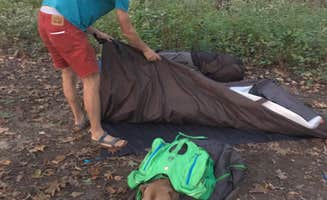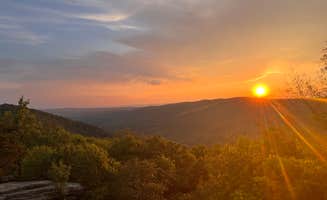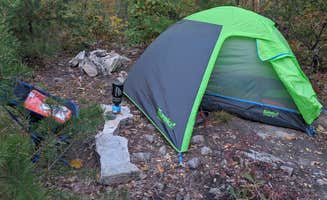Primitive camping near Brunswick, Maryland offers multiple options within a 30-mile radius, primarily in national forests and wildlife management areas. The terrain varies from river valleys to mountain ridgelines with elevation changes ranging from 400 to 1,200 feet. Many dispersed sites have seasonal access limitations during winter months when forest roads may become impassable due to snow or mud conditions.
What to do
Fishing at nearby streams: Edwards Run Wildlife Management Area provides stream fishing opportunities with relatively easy access. According to Jim M., "the site was level and grassy. Nice camp site" with convenient proximity to fishing spots.
Ridge hiking: Veach Gap - GWNF - Backpacking Site connects to longer trail networks for extended backpacking trips. TJ W. notes, "Went up in November with beautiful weather, fall leaves changing and great company. Couldn't have had a better experience."
Wildlife observation: The varied ecosystems around Brunswick support diverse wildlife viewing opportunities, particularly during dawn and dusk hours. Many campers report seeing deer, wild turkeys, and various bird species throughout the seasons.
What campers like
Cell service at high points: Some ridge camping locations provide unexpected connectivity. At Compton Gap Backcountry camping, hikers can find spots with cellular reception despite the remote setting, though Les R. warns it can be "Buggy and damp" during certain seasons.
Fire rings at established sites: Most primitive sites include basic stone fire rings from previous campers. Jon N. mentions regarding Veach Gap, "I've had good luck finding wood from dead trees at the top, but just make sure you're being safe and treating nature kindly."
Budget-friendly options: Several camping areas near Brunswick require minimal or no fees. Edwards Run Wildlife Management Area has a modest fee structure, though Jim M. notes there was "a kiosk with a sign that said $10 camping fee but no info on how or where to pay."
What you should know
Water source planning: Many sites lack reliable water sources, especially at higher elevations. Plan to carry all necessary water for your stay. Jon N. advises about Veach Gap, "there is no water after the first mile. I have seen a small trickle part way up the mountain, but don't count on it."
Navigation challenges: Forest service roads leading to primitive camping areas often lack clear signage. Download offline maps before departure and bring physical maps as backup.
Seasonal road conditions: Spring and winter access can be limited by mud or snow, particularly on unpaved forest roads. Four-wheel drive vehicles may be necessary during these periods.
Tips for camping with families
Choose walk-in sites: For families with young children, consider walk-in sites rather than longer hikes. Frank G. suggests at Edwards Run, "There's a lot by the road that looks like it's where they want you to camp but there are better sites on in. Just gotta hike to em."
Wildlife awareness: Teach children proper food storage techniques to avoid attracting bears and other wildlife. All food items should be stored in vehicles or hung properly when camping in these areas.
Trail difficulty assessment: Match hiking distances to children's abilities. The 4-mile, 1,200-foot elevation gain to some ridge sites may be challenging for younger children.
Tips from RVers
Road width limitations: Most forest service roads accessing primitive camping near Brunswick are narrow with limited turning areas. Small trailers under 20 feet may access some areas, but larger RVs will find few suitable options.
Leveling requirements: Bring adequate leveling blocks as most primitive sites feature uneven terrain. One camper notes that while some areas appear level from the road, they often have hidden slopes that become apparent only when setting up camp.
Boundary awareness: When camping with RVs in wildlife management areas, verify boundaries and designated camping zones. Some areas restrict vehicle camping to specific locations while allowing tent camping in broader zones.




